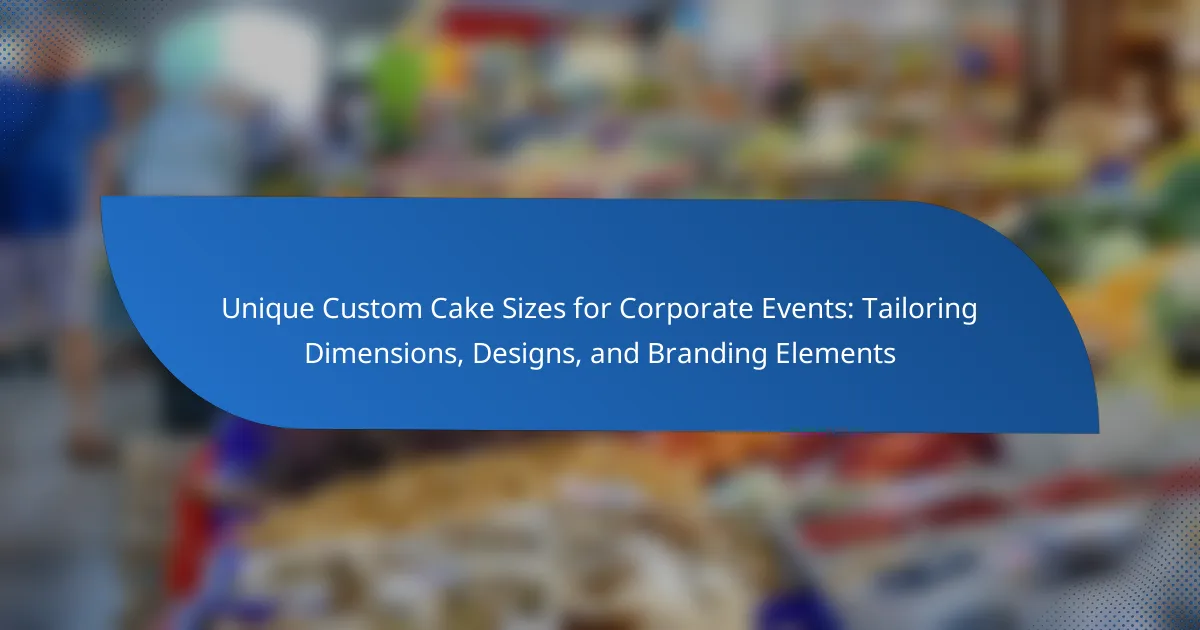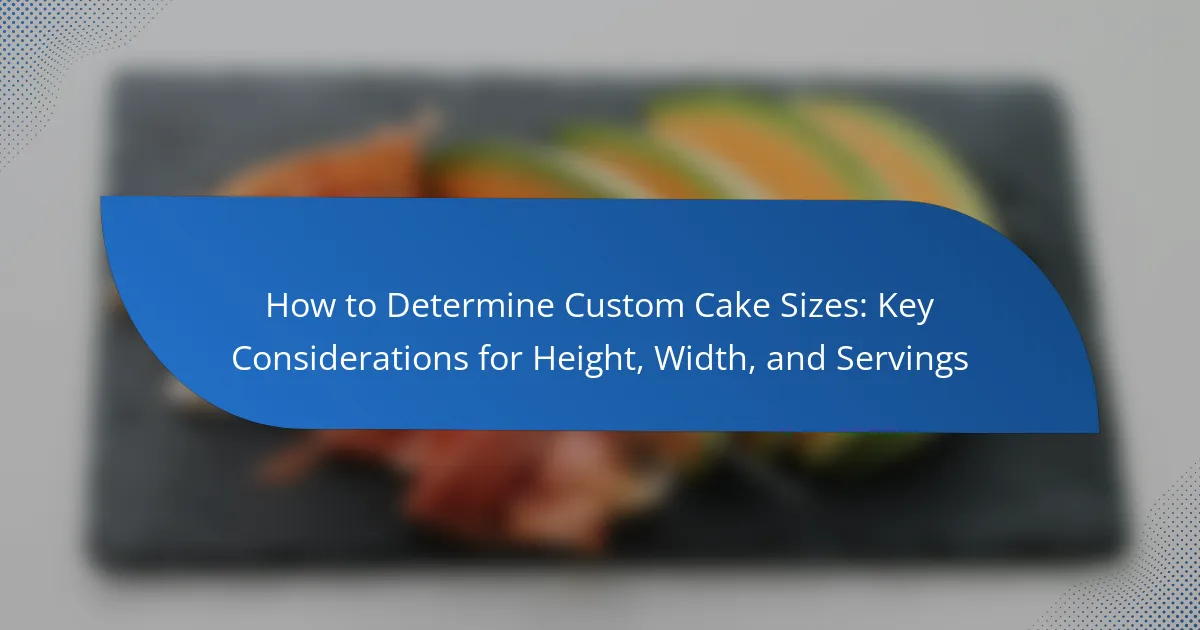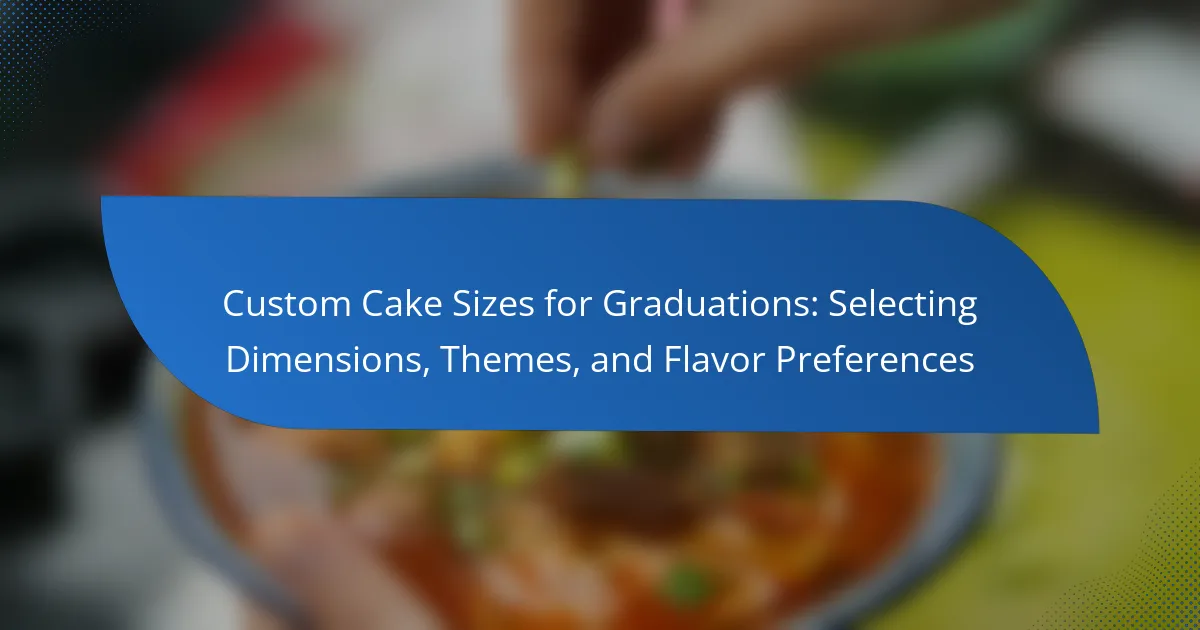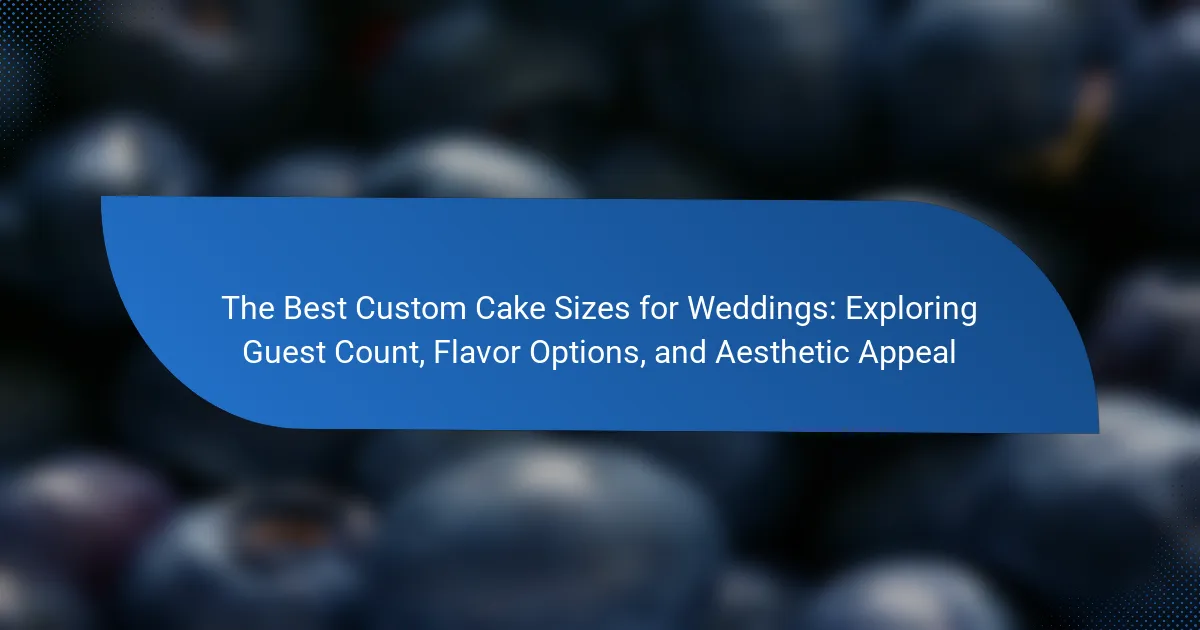Custom cake sizes are cakes made in specific dimensions tailored to meet individual needs for various occasions. This guide covers the importance of selecting the right cake size, which ensures it fits the event, serves the desired number of guests, and enhances visual appeal. It outlines standard dimensions for round and sheet cakes, detailing how size influences serving capacity and design possibilities. Smaller cakes are suitable for simple designs, while larger cakes accommodate intricate decorations and multiple tiers. Understanding these factors is essential for achieving balance in cake design and ensuring the success of any event.
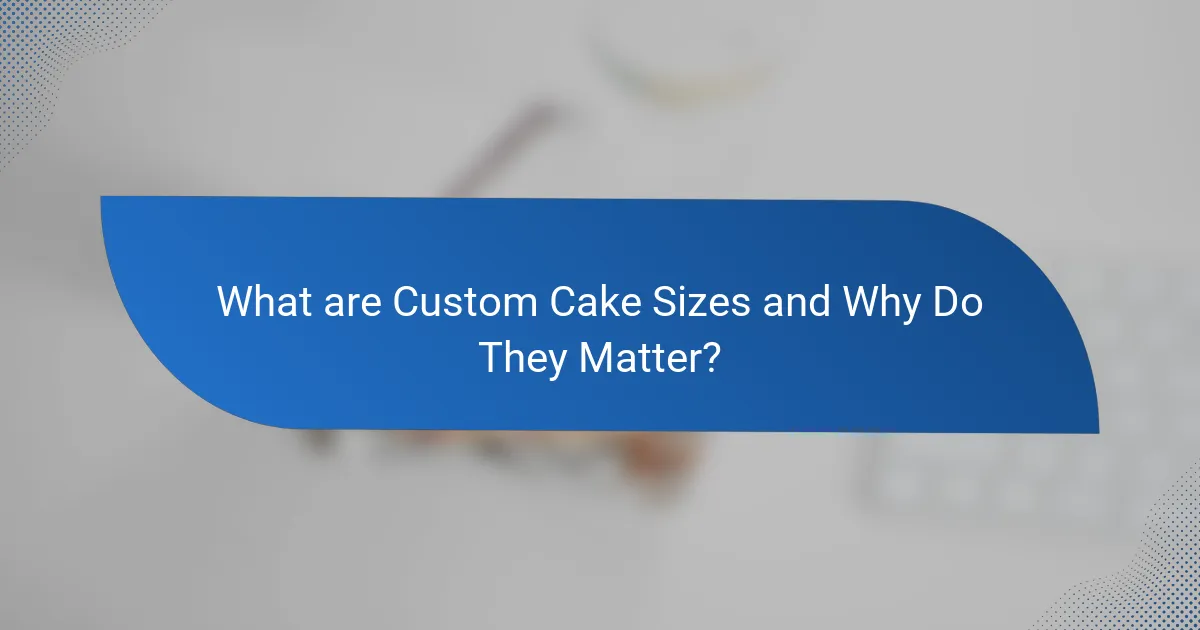
What are Custom Cake Sizes and Why Do They Matter?
Custom cake sizes refer to cakes made in specific dimensions tailored to individual needs. They matter because they ensure the cake fits the occasion and serves the desired number of guests. Custom sizes allow for flexibility in design and presentation. For example, a wedding cake may require larger tiers to accommodate more guests. Additionally, custom sizes can enhance the visual impact of the cake. By choosing the right size, clients can avoid waste or shortages. Accurate sizing is crucial for achieving balance in cake design. This attention to detail contributes to the overall success of an event.
How do different cake sizes impact servings?
Different cake sizes directly impact the number of servings available. For instance, a 6-inch round cake typically serves about 8 to 10 people. A 9-inch round cake can serve 12 to 16 people. A 10-inch round cake usually provides 16 to 20 servings. Larger cakes, such as a 12-inch round, can serve 24 to 30 people. The size and shape of the cake determine portion sizes and overall servings. Standard serving sizes are approximately 1 inch by 2 inches for layered cakes. Therefore, selecting a cake size based on the number of guests is crucial for adequate servings.
What are the standard servings for popular cake sizes?
A standard 6-inch round cake serves about 6-8 people. A 8-inch round cake typically serves 10-12 people. A 9-inch round cake can serve 12-14 people. A 10-inch round cake generally serves 14-20 people. A 12-inch round cake usually serves 20-30 people. A ¼ sheet cake serves approximately 12-20 people. A ½ sheet cake can serve around 20-40 people. A full sheet cake typically serves 40-96 people, depending on portion size. These serving sizes are based on average cake portioning practices.
How can serving sizes affect event planning?
Serving sizes directly impact event planning by determining the quantity of food and beverages needed. Accurate serving sizes ensure that all guests are adequately catered to. If serving sizes are underestimated, there may not be enough food, leading to guest dissatisfaction. Conversely, overestimating serving sizes can result in excessive waste and increased costs. For example, a standard cake serving is typically 1 slice per person. If an event has 100 guests, a cake that serves 100 will suffice. Planning for the correct serving sizes helps streamline budgeting and reduces stress on event organizers.
What occasions typically require custom cake sizes?
Custom cake sizes are typically required for special occasions such as weddings, birthdays, and corporate events. Weddings often require large cakes to serve many guests, with sizes tailored to specific guest counts. Birthdays may necessitate custom sizes to fit themes or age milestones, ensuring an impressive presentation. Corporate events might need unique dimensions to align with branding or to fit specific display areas. Additionally, anniversaries and graduations often call for custom cakes that reflect the significance of the celebration. Each occasion has unique requirements that dictate the size and design of the cake.
How do wedding cakes differ in size from birthday cakes?
Wedding cakes typically differ in size from birthday cakes in that they are generally larger. Wedding cakes are designed to serve more guests, often ranging from 50 to 300 servings. In contrast, birthday cakes usually serve fewer guests, often between 8 to 30 servings. The larger size of wedding cakes accommodates multiple tiers and intricate designs. Birthday cakes are often simpler and can be single or double-layered. The need for larger wedding cakes stems from the tradition of serving all guests at a wedding. This distinction in size reflects the different occasions and guest counts associated with each type of celebration.
What considerations should be made for corporate events?
When planning corporate events, several key considerations must be addressed. First, the event’s purpose should be clearly defined. This purpose will guide decisions regarding the venue, catering, and agenda. Next, the target audience must be identified. Understanding the audience helps tailor the event to their preferences and expectations. Budget constraints are also crucial. A well-defined budget ensures that all aspects of the event are adequately funded.
Venue selection is another critical factor. The venue should accommodate the expected number of attendees comfortably. Logistics, including transportation and accessibility, must be considered to ensure smooth attendance. Additionally, the event schedule should allow for networking opportunities. Such opportunities can enhance engagement among participants. Lastly, feedback mechanisms should be established. Gathering feedback post-event can provide valuable insights for future events.
How can you choose the right cake size for your event?
To choose the right cake size for your event, first determine the number of guests. A standard serving size is typically 1 slice per person. For example, a 6-inch cake serves about 12 people, while a 10-inch cake serves approximately 30.
Consider the type of event as well. Birthdays may require larger cakes, while smaller gatherings can suffice with mini cakes. Additionally, factor in other desserts being served. If there are multiple dessert options, a smaller cake may be appropriate.
Finally, consider the cake’s design and tiers. Elaborate designs may necessitate a larger cake to maintain proportions. Always consult with your baker for specific recommendations based on your event’s needs.
What factors should be considered when selecting a cake size?
When selecting a cake size, consider the number of servings required. The size should accommodate all guests at the event. Additionally, the occasion type influences the cake size. Weddings typically require larger cakes compared to birthday parties. The cake’s design also affects its dimensions. Intricate designs may require more space. Lastly, budget constraints play a crucial role. Larger cakes generally cost more to produce.
How does guest count influence cake size decisions?
Guest count directly influences cake size decisions. A higher number of guests typically requires a larger cake to ensure everyone is served. Cake serving sizes usually range from 1 to 2 inches per slice. For example, a standard wedding cake may serve 100 guests with a 6-inch, 8-inch, and 10-inch tier arrangement. Conversely, a small gathering of 20 guests would need a smaller cake, such as a single-tier cake. Accurate guest counts help bakers determine the necessary cake dimensions to avoid shortages or excess. Therefore, understanding the guest count is crucial for appropriate cake sizing.
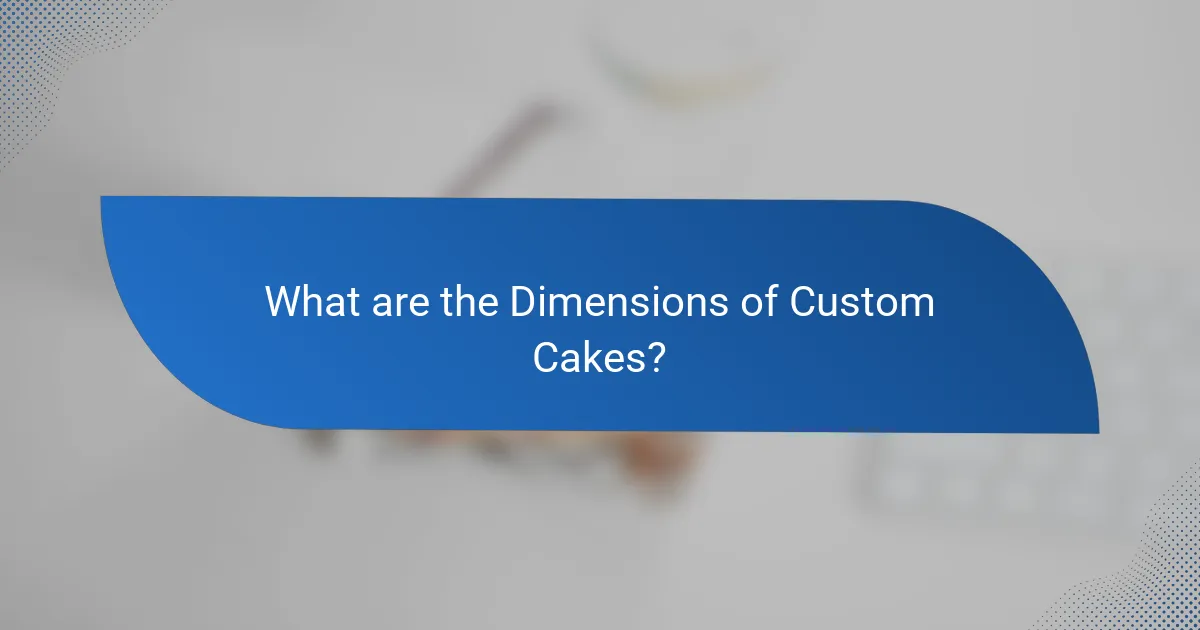
What are the Dimensions of Custom Cakes?
Custom cakes typically come in various dimensions to accommodate different serving sizes and designs. Common round cake sizes include 6 inches, 8 inches, 10 inches, and 12 inches in diameter. Sheet cakes often range from 1/4 sheet (9 x 13 inches) to full sheet (26 x 18 inches). The height of custom cakes usually varies from 4 to 6 inches, but multi-tiered cakes can be taller. The choice of dimensions often depends on the number of servings required. For instance, a 6-inch round cake serves about 6-8 people, while a 10-inch round cake serves approximately 20-25 people. These standard sizes help bakers create cakes that meet specific event needs.
How are cake dimensions measured?
Cake dimensions are measured in terms of diameter and height. The diameter is the width of the cake when viewed from above. It is typically measured across the center of the cake. Height refers to how tall the cake is from the base to the top. Height is measured vertically, often using a ruler or measuring tape. Standard cake sizes include 6-inch, 8-inch, and 10-inch diameters. Cakes can also vary in height, commonly ranging from 2 to 6 inches. Accurate measurements ensure proper serving sizes and design compatibility.
What are the common height and diameter measurements for cakes?
Common height and diameter measurements for cakes typically include 6, 8, and 10 inches in diameter. The standard height for cakes is usually 2 to 4 inches. For tiered cakes, each tier often measures around 4 inches in height. These dimensions are widely used for various occasions. A 6-inch cake serves about 6 to 8 people. An 8-inch cake serves approximately 12 to 14 people. A 10-inch cake can serve around 20 to 24 people. These measurements ensure appropriate servings for gatherings and celebrations.
How do dimensions affect the overall look of the cake?
Dimensions significantly influence the overall look of a cake. The height, width, and shape determine its visual impact. Taller cakes create a more dramatic appearance, while shorter cakes appear more subdued. Wider cakes can accommodate more decorations, enhancing visual appeal. The shape, whether round, square, or custom, affects how the cake is perceived. For example, round cakes often seem more traditional, while square cakes can appear modern. The ratio of height to width also plays a role; a well-proportioned cake looks balanced. In summary, the dimensions of a cake are crucial for its aesthetic presentation and can convey different themes or styles.
What are the most popular cake sizes for various occasions?
The most popular cake sizes for various occasions include 6-inch, 8-inch, 10-inch, and sheet cakes. A 6-inch cake typically serves 6-8 people, making it ideal for small gatherings or intimate celebrations. An 8-inch cake serves about 10-12 people, suitable for birthdays or small parties. The 10-inch cake can accommodate 15-20 guests, often chosen for larger gatherings or family events. Sheet cakes, such as quarter, half, or full sheets, serve 20, 40, or 96 people respectively, making them perfect for weddings, corporate events, or large celebrations. These sizes are commonly used due to their versatility and ability to meet varying guest counts.
What sizes work best for small gatherings?
The best cake sizes for small gatherings typically range from 6 to 10 inches in diameter. A 6-inch cake generally serves about 6 to 8 people. This size is ideal for intimate celebrations. An 8-inch cake can serve approximately 12 to 16 guests. This size works well for slightly larger small gatherings. A 10-inch cake can accommodate around 20 people. This size is suitable for small parties or family gatherings. Choosing the right size ensures everyone receives a slice without excess waste.
Which sizes are appropriate for large celebrations?
For large celebrations, cake sizes typically range from 10 inches to 16 inches in diameter. A 10-inch cake serves approximately 25 people. An 12-inch cake can serve around 40 guests. A 14-inch cake accommodates about 60 servings. A 16-inch cake can serve up to 80 individuals. These sizes ensure that there is enough cake for all attendees. Larger cakes can be tiered for an impressive presentation. Using these dimensions helps in planning for the number of guests effectively.
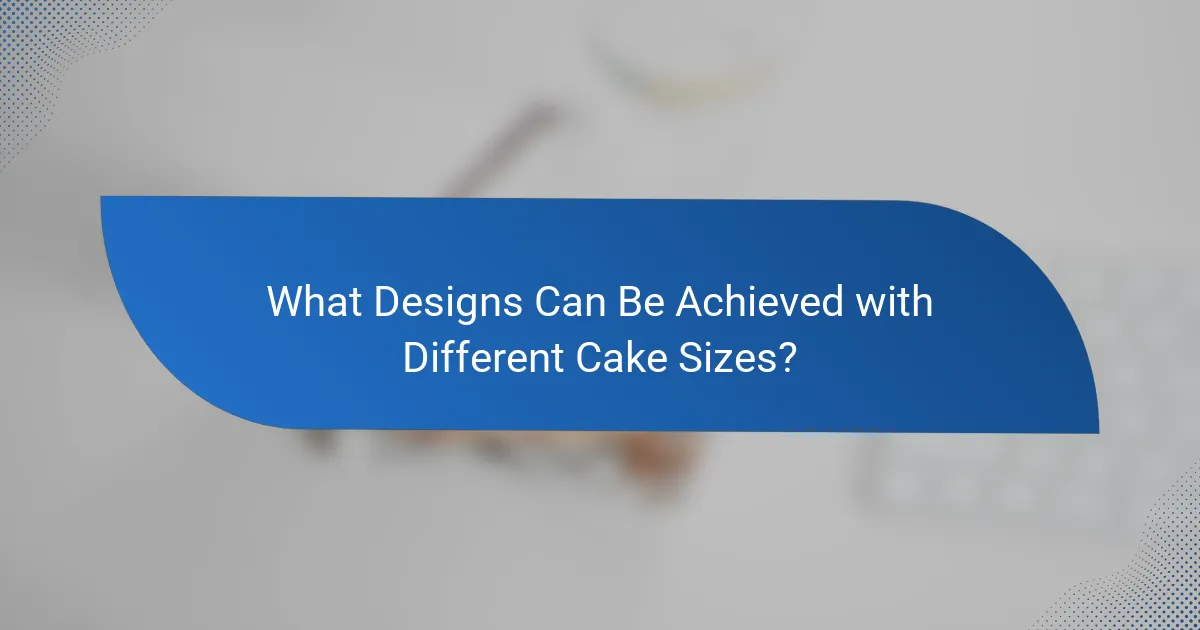
What Designs Can Be Achieved with Different Cake Sizes?
Different cake sizes allow for a variety of designs. Smaller cakes, such as 6-inch or 8-inch, are ideal for simple, elegant designs. They can feature minimalistic decorations like fresh flowers or a smooth buttercream finish. Medium-sized cakes, like 10-inch or 12-inch, can accommodate more intricate designs. These sizes allow for multiple tiers and detailed decorations, such as fondant work or themed embellishments. Larger cakes, such as 14-inch or 16-inch, provide ample space for elaborate designs. They can support multiple tiers and complex decorations, including sculpted elements or elaborate patterns. Each cake size influences the design possibilities, enabling bakers to create visually stunning and customized cakes for various occasions.
How does cake size influence design options?
Cake size directly influences design options by determining the available surface area for decoration. Larger cakes provide more space for intricate designs, multiple tiers, and detailed embellishments. Smaller cakes limit design complexity due to reduced space. For instance, a three-tiered cake allows for more elaborate decorations compared to a single-layer cake. Additionally, the size affects the choice of cake type and flavor combinations. Larger cakes may require more structural support, influencing the design approach. Ultimately, the size dictates the overall aesthetic possibilities and practical considerations in cake design.
What are the design limitations of smaller cakes?
Smaller cakes have several design limitations. Their reduced surface area restricts intricate detailing and decoration. Complex designs may appear cramped or disproportionate on smaller cakes. The weight distribution can be affected, leading to stability issues. Smaller cakes often require simpler structures to maintain integrity. Limited layers can restrict flavor variety and texture combinations. Additionally, smaller cakes may not support elaborate toppers or embellishments. These factors collectively constrain the overall aesthetic and functional possibilities for smaller cakes.
How can larger cakes accommodate more intricate designs?
Larger cakes can accommodate more intricate designs due to their increased surface area. This additional space allows for detailed decorations, such as fondant work, piping, and edible images. Larger cakes also provide more structural support for complex designs, enabling the use of tiers and multiple layers. Each layer can feature unique designs, enhancing overall visual appeal. Moreover, larger cakes can incorporate more diverse flavors and fillings, which can be reflected in the design. These factors contribute to the ability to create elaborate and eye-catching cake designs for special occasions.
What are some popular design themes for custom cakes?
Popular design themes for custom cakes include floral, vintage, and modern minimalist styles. Floral designs often feature intricate sugar flowers and natural colors. Vintage themes utilize lace, soft pastels, and classic patterns. Modern minimalist cakes emphasize clean lines and simple designs, often with a single bold color. Other popular themes are themed cakes based on movies or hobbies, which can incorporate specific colors and elements related to the theme. Seasonal themes, such as winter wonderland or summer beach, also inspire unique designs. Each theme can be customized to fit the occasion, making them versatile for birthdays, weddings, and other celebrations.
How can seasonal themes affect cake design choices?
Seasonal themes significantly influence cake design choices. Each season brings distinct colors, flavors, and motifs. For example, spring often features pastel colors and floral designs. Summer cakes may incorporate bright colors and tropical elements. Autumn designs typically utilize warm hues and harvest motifs like pumpkins. Winter cakes frequently showcase icy designs and holiday themes. These seasonal elements guide bakers in selecting appropriate decorations and flavors. Custom cakes that align with seasonal themes enhance visual appeal and customer satisfaction.
What unique designs can be created for milestone events?
Unique designs for milestone events include tiered cakes, themed cakes, and personalized cakes. Tiered cakes can showcase multiple layers, each with distinct flavors or colors. Themed cakes often reflect the event’s significance, such as a graduation cap for graduation parties. Personalized cakes can feature names, dates, or images that commemorate the occasion. These designs enhance the visual appeal and emotional connection to the event. According to a survey by The Knot, 80% of couples prioritize unique cake designs for their weddings, highlighting the importance of custom designs in milestone celebrations.
What Tips Should You Follow When Ordering a Custom Cake?
When ordering a custom cake, communicate your vision clearly. Specify the occasion, theme, and flavor preferences. Provide details about the desired size and number of servings. Share any design inspirations or examples you have in mind. Discuss dietary restrictions or allergies with the baker. Confirm the order well in advance to ensure availability. Request a quote and inquire about any additional costs for custom designs. Lastly, verify the pickup or delivery arrangements to avoid last-minute issues.
How can you communicate your size and design preferences effectively?
To communicate your size and design preferences effectively, be clear and specific about your requirements. Start by determining the number of servings needed for the occasion. Use standard serving sizes as a reference, which generally range from 1 to 2 inches per slice. Next, describe the desired cake dimensions in inches, including height and width. Specify any design elements you envision, such as themes, colors, or decorations. Providing visual references, such as photos or sketches, can enhance understanding. Clearly stating any dietary restrictions or flavor preferences is also important. This method ensures that your expectations align with the baker’s capabilities.
What should you consider when working with a baker on custom sizes?
When working with a baker on custom sizes, consider the number of servings needed. Different cake sizes yield different portions. Discuss the desired shape, as this affects dimensions. Specify any dietary restrictions or preferences, such as gluten-free or vegan. Communicate your design ideas clearly to ensure they fit the size. Confirm the baking time required for larger cakes, as it may differ from standard sizes. Understand that custom sizes may affect pricing, so ask for a detailed quote. Finally, verify the baker’s experience with custom orders to ensure quality.
Custom cake sizes are tailored dimensions designed to meet specific event needs, ensuring the cake fits the occasion and serves the appropriate number of guests. This guide covers the impact of different cake sizes on servings, the standard sizes for popular occasions, and the design possibilities that arise from varying dimensions. It highlights the importance of accurately sizing cakes for events like weddings, birthdays, and corporate gatherings, while also addressing considerations for selecting the right size based on guest counts and design preferences. Additionally, the article provides practical tips for ordering custom cakes and communicating effectively with bakers.
